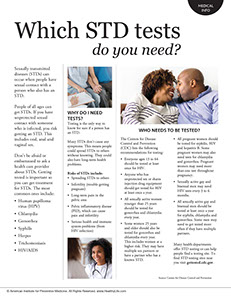SYMPTOM CHECKER
CONDITIONS
Male
Female
Child
Arm, Hand & Shoulder Concerns
Legs & Feet Concerns
Dental & Mouth Concerns
Ear & Nose
Eye Conditions
Head Conditions
Arm, Hand & Shoulder Concerns
Legs & Feet Concerns
Front
Back
Arm, Hand & Shoulder Concerns
Dental & Mouth Concerns
Ear & Nose
Eye Conditions
Head Conditions
Arm, Hand & Shoulder Concerns
Dental & Mouth Concerns
Ear & Nose
Eye Conditions
Head Conditions
Front
Back
Arm, Hand & Shoulder Concerns
Neck Links
Head & Neck Concerns
Arm, Hand & Shoulder Concerns
Neck Links
Head & Neck Concerns
Front
Back
Online Clinic
Wise Healthcare
Which STD tests do you need?
Print on Demand
Sexually transmitted diseases (STDs) can occur when people have sexual contact with a person who also has an STD.
People of all ages can get STDs. If you have unprotected sexual contact with someone who is infected, you risk getting an STD. This includes oral, anal and vaginal sex.
Don’t be afraid or embarrassed to ask a health care provider about STDs. Getting tested is important so you can get treatment for STDs. The most common ones include:
• Human papilloma virus (HPV)
• Chlamydia
• Gonorrhea
• Syphilis
• Herpes
• Trichomoniasis
• HIV/AIDS
Why do I need tests?
Testing is the only way to know for sure if a person has an STD. Many STDs don’t cause any symptoms. This means people could spread STDs to others without knowing. They could also have long-term health problems.
Risks of STDs include:
• Spreading STDs to others
• Infertility (trouble getting pregnant)
• Long-term pain in the pelvic area
• Pelvic inflammatory disease (PID), which can cause pain and infertility
• Serious health and immune system problems (from HIV infection)
Who needs to be tested?
The Centers for Disease Control and Prevention (CDC) lists the following recommendations for testing:
• Everyone ages 13 to 64 should be tested at least once for HIV.
• Anyone who has unprotected sex or shares injection drug equipment should get tested for HIV at least once a year.
• All sexually active women younger than 25 years should be tested for gonorrhea and chlamydia every year.
• Some women 25 years and older should also be tested for gonorrhea and chlamydia every year. This includes women at a higher risk. They may have multiple sex partners or have a partner who has a known STD.
• All pregnant women should be tested for syphilis, HIV and hepatitis B. Some pregnant women may also need tests for chlamydia and gonorrhea. Pregnant women may need more than one test throughout pregnancy.
• Sexually active gay and bisexual men may need HIV tests every 3 to 6 months.
• All sexually active gay and bisexual men should be tested at least once a year for syphilis, chlamydia and gonorrhea. Some men may need to get tested more often if they have multiple partners.
Many health departments offer STD testing or can help people find a testing site. To find STD testing sites near you visit gettested.cdc.gov.
Source: Centers for Disease Control and Prevention
RELATED ARTICLES
This website is not meant to substitute for expert medical advice or treatment. Follow your doctor’s or health care provider’s advice if it differs from what is given in this guide.
The American Institute for Preventive Medicine (AIPM) is not responsible for the availability or content of external sites, nor does AIPM endorse them. Also, it is the responsibility of the user to examine the copyright and licensing restrictions of external pages and to secure all necessary permission.
The content on this website is proprietary. You may not modify, copy, reproduce, republish, upload, post, transmit, or distribute, in any manner, the material on the website without the written permission of AIPM.
2021 © American Institute for Preventive Medicine - All Rights Reserved. Disclaimer | www.HealthyLife.com
















































